Practice Question - 76 (Scheduling) | 100 DILR Questions for CAT Preparation PDF Download
A visa processing office (VPO) accepts visa applications in four categories - US, UK, Schengen, and Others. The applications are scheduled for processing in twenty 15- minute slots starting at 9:00 am and ending at 2:00 pm. Ten applications are scheduled in each slot.
There are ten counters in the office, four dedicated to US applications, and two each for UK applications, Schengen applications and Others applications. Applicants are called in for processing sequentially on a first-come-first-served basis whenever a counter gets freed for their category. The processing time for an application is the same within each category. But it may vary across the categories. Each US and UK application requires 10 minutes of processing time. Depending on the number of applications in a category and time required to process an application for that category, it is possible that an applicant for a slot may be processed later.
On a particular day, Ira, Vijay and Nandini were scheduled for Schengen visa processing in that order. They had a 9:15 am slot but entered the VPO at 9:20 am. When they entered the office, exactly six out of the ten counters were either processing applications, or had finished processing one and ready to start processing the next.
Mahira and Osman were scheduled in the 9:30 am slot on that day for visa processing in the Others category.
The following additional information is known about that day.
- All slots were full.
- The number of US applications was the same in all the slots. The same was true for the other three categories.
- 50% of the applications were US applications.
- All applicants except Ira, Vijay and Nandini arrived on time.
- Vijay was called to a counter at 9:25 am.
Q1: How many UK applications were scheduled on that day?
 View Answer
View Answer 
Ans: 0
It is given that the applications are scheduled for processing in twenty 15-minute slots starting at 9:00 am and ending at 2:00 pm. Ten applications are scheduled in each slot.
Hence, the total number of applicants = (20 * 10) = 200. It is also known that 50% of the applications were US applications, and the number of US applications was the same in all the slots. The same was true for the other three categories.
Hence, the number of total number of US applicants = (200 * 50 %) = 100, and the number of US applicants in each slot = (100 / 20) = 5
It is also known that Ira, Vijay, and Nandini were scheduled for Schengen visa processing in that order. They had a 9:15 am slot. Since the number of Schengen applicants was the same in all the slots, it implies the number of Schengen applicants in each slot is at least 3.
Similarly, it is given that Mahira and Osman were scheduled in the 9:30 am slot on that day for visa processing in the Others category, which implies the number of other category applicants in each slot is at least 2. Since the number of total applicants in each slot is 10, this implies the number of Schengen and other applicants in each slot is 3, and 2, respectively. Hence, the number of UK applicants is 0 in each slot.
It is also known that the number of total counters is 10, among which four are dedicated to US applications, and two each for UK applications, Schengen applications, and Others applications. It is given that each US and UK application requires 10 minutes of processing time, and Vijay was called to a counter at 9:25 am. (Who is 5th in the queue). It can only be possible when the processing time of Schengen applications is 12.5 minutes.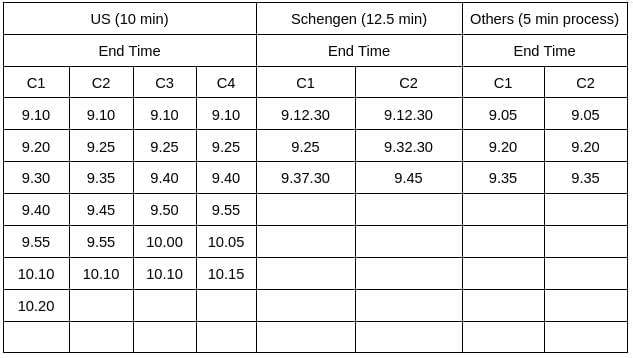
On a particular day, Ira, Vijay, and Nandini were scheduled for Schengen visa processing in that order. They had a 9:15 am slot but entered the VPO at 9:20 am. When they entered the office, exactly six out of the ten counters were either processing applications, or had finished processing one and ready to start processing the next. Hence, at 9.20 am, there are exactly four free counters. Out of these 4, 2 is the UK counter, and the other two are other counters. (Since the US counters and Schengen Counters were either processing applications, or had finished processing one and were ready to start processing the next.)
From the table, we can say that the total number of UK applicants in each slot is zero, Hence, the total number of applicants is zero.
Q2: What is the maximum possible value of the total time (in minutes, nearest to its integer value) required to process all applications in the Others category on that day?
 View Answer
View Answer 
Ans: 200
It is given that the applications are scheduled for processing in twenty 15-minute slots starting at 9:00 am and ending at 2:00 pm. Ten applications are scheduled in each slot.
Hence, the total number of applicants = (20 * 10) = 200. It is also known that 50% of the applications were US applications, and the number of US applications was the same in all the slots. The same was true for the other three categories.
Hence, the number of total number of US applicants = (200 * 50 %) = 100, and the number of US applicants in each slot = (100 / 20) = 5
It is also known that Ira, Vijay, and Nandini were scheduled for Schengen visa processing in that order. They had a 9:15 am slot. Since the number of Schengen applicants was the same in all the slots, it implies the number of Schengen applicants in each slot is at least 3.
Similarly, it is given that Mahira and Osman were scheduled in the 9:30 am slot on that day for visa processing in the Others category, which implies the number of other category applicants in each slot is at least 2. Since the number of total applicants in each slot is 10, this implies the number of Schengen and other applicants in each slot is 3, and 2, respectively. Hence, the number of UK applicants is 0 in each slot.
It is also known that the number of total counters is 10, among which four are dedicated to US applications, and two each for UK applications, Schengen applications, and Others applications. It is given that each US and UK application requires 10 minutes of processing time, and Vijay was called to a counter at 9:25 am. (Who is 5th in the queue). It can only be possible when the processing time of Schengen applications is 12.5 minutes.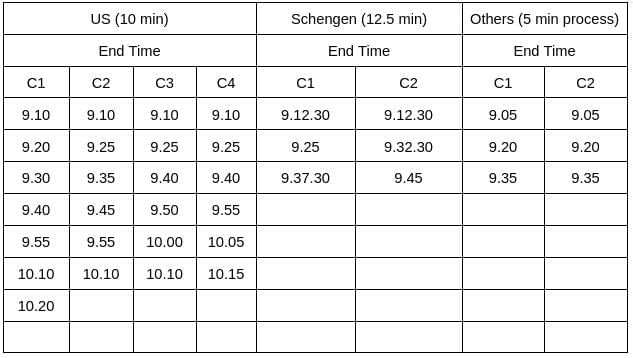
On a particular day, Ira, Vijay, and Nandini were scheduled for Schengen visa processing in that order. They had a 9:15 am slot but entered the VPO at 9:20 am. When they entered the office, exactly six out of the ten counters were either processing applications, or had finished processing one and ready to start processing the next. Hence, at 9.20 am, there are exactly four free counters. Out of these 4, 2 is the UK counter, and the other two are other counters. (Since the US counters and Schengen Counters were either processing applications, or had finished processing one and were ready to start processing the next.)
For the other applicants, the time taken to process one application is at most 5 minutes, which implies the total time taken to process 40 applications is at most (40 * 5) = 200 minutes.
Q3: Which of the following is the closest to the time when Nandini’s application process got over?
(a) 9:50 am
(b) 9:37 am
(c) 9:35 am
(d) 9:45 am
 View Answer
View Answer 
Ans: (d)
It is given that the applications are scheduled for processing in twenty 15-minute slots starting at 9:00 am and ending at 2:00 pm. Ten applications are scheduled in each slot.
Hence, the total number of applicants = (20 * 10) = 200. It is also known that 50% of the applications were US applications, and the number of US applications was the same in all the slots. The same was true for the other three categories.
Hence, the number of total number of US applicants = (200 * 50 %) = 100, and the number of US applicants in each slot = (100 / 20) = 5
It is also known that Ira, Vijay, and Nandini were scheduled for Schengen visa processing in that order. They had a 9:15 am slot. Since the number of Schengen applicants was the same in all the slots, it implies the number of Schengen applicants in each slot is at least 3.
Similarly, it is given that Mahira and Osman were scheduled in the 9:30 am slot on that day for visa processing in the Others category, which implies the number of other category applicants in each slot is at least 2. Since the number of total applicants in each slot is 10, this implies the number of Schengen and other applicants in each slot is 3, and 2, respectively. Hence, the number of UK applicants is 0 in each slot.
It is also known that the number of total counters is 10, among which four are dedicated to US applications, and two each for UK applications, Schengen applications, and Others applications. It is given that each US and UK application requires 10 minutes of processing time, and Vijay was called to a counter at 9:25 am. (Who is 5th in the queue). It can only be possible when the processing time of Schengen applications is 12.5 minutes.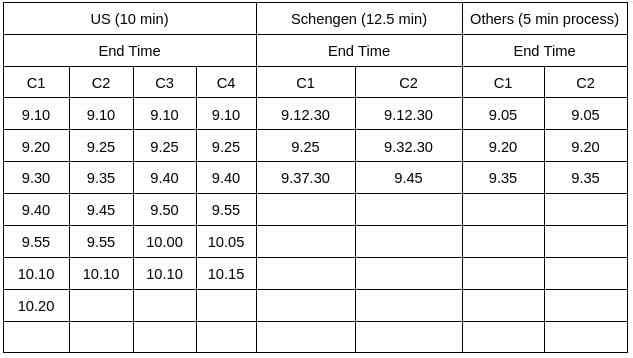 On a particular day, Ira, Vijay, and Nandini were scheduled for Schengen visa processing in that order. They had a 9:15 am slot but entered the VPO at 9:20 am. When they entered the office, exactly six out of the ten counters were either processing applications, or had finished processing one and ready to start processing the next. Hence, at 9.20 am, there are exactly four free counters. Out of these 4, 2 is the UK counter, and the other two are other counters. (Since the US counters and Schengen Counters were either processing applications, or had finished processing one and were ready to start processing the next.)
On a particular day, Ira, Vijay, and Nandini were scheduled for Schengen visa processing in that order. They had a 9:15 am slot but entered the VPO at 9:20 am. When they entered the office, exactly six out of the ten counters were either processing applications, or had finished processing one and ready to start processing the next. Hence, at 9.20 am, there are exactly four free counters. Out of these 4, 2 is the UK counter, and the other two are other counters. (Since the US counters and Schengen Counters were either processing applications, or had finished processing one and were ready to start processing the next.)
Nandini's position was sixth in the queue in the Schengen Applications. From the table, we can see that her process will end at 9.45 am.
The correct option is D
Q4: Which of the following statements is false?
(a) The application process of Osman was completed before 9:45 am.
(b) The application process of Mahira started after Nandini’s.
(c) The application process of Osman was completed before Vijay’s.
(d) The application process of Mahira was completed before Nandini’s.
 View Answer
View Answer 
Ans: (b)
It is given that the applications are scheduled for processing in twenty 15-minute slots starting at 9:00 am and ending at 2:00 pm. Ten applications are scheduled in each slot.
Hence, the total number of applicants = (20 * 10) = 200. It is also known that 50% of the applications were US applications, and the number of US applications was the same in all the slots. The same was true for the other three categories.
Hence, the number of total number of US applicants = (200 * 50 %) = 100, and the number of US applicants in each slot = (100 / 20) = 5
It is also known that Ira, Vijay, and Nandini were scheduled for Schengen visa processing in that order. They had a 9:15 am slot. Since the number of Schengen applicants was the same in all the slots, it implies the number of Schengen applicants in each slot is at least 3.
Similarly, it is given that Mahira and Osman were scheduled in the 9:30 am slot on that day for visa processing in the Others category, which implies the number of other category applicants in each slot is at least 2. Since the number of total applicants in each slot is 10, this implies the number of Schengen and other applicants in each slot is 3, and 2, respectively. Hence, the number of UK applicants is 0 in each slot.
It is also known that the number of total counters is 10, among which four are dedicated to US applications, and two each for UK applications, Schengen applications, and Others applications. It is given that each US and UK application requires 10 minutes of processing time, and Vijay was called to a counter at 9:25 am. (Who is 5th in the queue). It can only be possible when the processing time of Schengen applications is 12.5 minutes.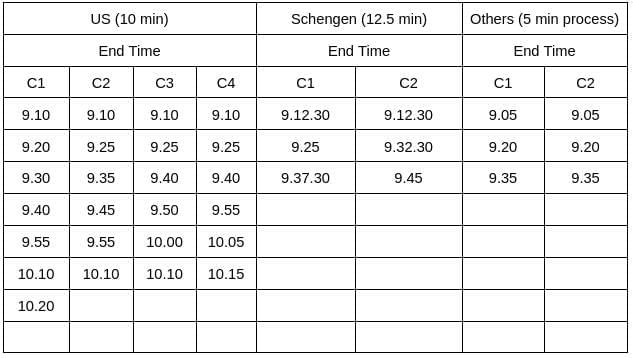 On a particular day, Ira, Vijay, and Nandini were scheduled for Schengen visa processing in that order. They had a 9:15 am slot but entered the VPO at 9:20 am. When they entered the office, exactly six out of the ten counters were either processing applications, or had finished processing one and ready to start processing the next. Hence, at 9.20 am, there are exactly four free counters. Out of these 4, 2 is the UK counter, and the other two are other counters. (Since the US counters and Schengen Counters were either processing applications, or had finished processing one and were ready to start processing the next.)
On a particular day, Ira, Vijay, and Nandini were scheduled for Schengen visa processing in that order. They had a 9:15 am slot but entered the VPO at 9:20 am. When they entered the office, exactly six out of the ten counters were either processing applications, or had finished processing one and ready to start processing the next. Hence, at 9.20 am, there are exactly four free counters. Out of these 4, 2 is the UK counter, and the other two are other counters. (Since the US counters and Schengen Counters were either processing applications, or had finished processing one and were ready to start processing the next.)
Let's check the options.
Option (a): The application process of Osman was completed before 9:45 am. ⇒
Option (b): The application process of Mahira started after Nandini’s. ⇒ The application process for Mahira starts at 9.30 am, and the application process for Nandini starts at 9.32.30 am => False.
The correct option is (b)
Q5: When did the application processing for all US applicants get over on that day?
(a) 2:05 pm
(b) 2:25 pm
(c) 2:00 pm
(d) 3:40 pm
 View Answer
View Answer 
Ans: (a)
It is given that the applications are scheduled for processing in twenty 15-minute slots starting at 9:00 am and ending at 2:00 pm. Ten applications are scheduled in each slot.
Hence, the total number of applicants = (20 * 10) = 200. It is also known that 50% of the applications were US applications, and the number of US applications was the same in all the slots. The same was true for the other three categories.
Hence, the number of total number of US applicants = (200 * 50 %) = 100, and the number of US applicants in each slot = (100 / 20) = 5
It is also known that Ira, Vijay, and Nandini were scheduled for Schengen visa processing in that order. They had a 9:15 am slot. Since the number of Schengen applicants was the same in all the slots, it implies the number of Schengen applicants in each slot is at least 3.
Similarly, it is given that Mahira and Osman were scheduled in the 9:30 am slot on that day for visa processing in the Others category, which implies the number of other category applicants in each slot is at least 2. Since the number of total applicants in each slot is 10, this implies the number of Schengen and other applicants in each slot is 3, and 2, respectively. Hence, the number of UK applicants is 0 in each slot.
It is also known that the number of total counters is 10, among which four are dedicated to US applications, and two each for UK applications, Schengen applications, and Others applications. It is given that each US and UK application requires 10 minutes of processing time, and Vijay was called to a counter at 9:25 am. (Who is 5th in the queue). It can only be possible when the processing time of Schengen applications is 12.5 minutes.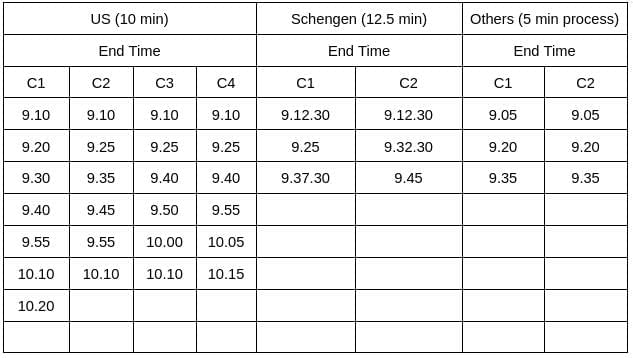 On a particular day, Ira, Vijay, and Nandini were scheduled for Schengen visa processing in that order. They had a 9:15 am slot but entered the VPO at 9:20 am. When they entered the office, exactly six out of the ten counters were either processing applications, or had finished processing one and ready to start processing the next. Hence, at 9.20 am, there are exactly four free counters. Out of these 4, 2 is the UK counter, and the other two are other counters. (Since the US counters and Schengen Counters were either processing applications, or had finished processing one and were ready to start processing the next.)
On a particular day, Ira, Vijay, and Nandini were scheduled for Schengen visa processing in that order. They had a 9:15 am slot but entered the VPO at 9:20 am. When they entered the office, exactly six out of the ten counters were either processing applications, or had finished processing one and ready to start processing the next. Hence, at 9.20 am, there are exactly four free counters. Out of these 4, 2 is the UK counter, and the other two are other counters. (Since the US counters and Schengen Counters were either processing applications, or had finished processing one and were ready to start processing the next.)
From the table, we can see that the first slot takes 20 minutes to complete, and after that remaining 19 slots take 15 minutes each to complete the US application process.
Hence, the total time taken = 20 + 15 * 19 = 305 minutes = 5 hrs 5 minutes. Hence, the time will be (9 am + 5hrs 5 minutes) = 2.05 pm
The correct option is (a)
|
102 videos|123 docs|121 tests
|
FAQs on Practice Question - 76 (Scheduling) - 100 DILR Questions for CAT Preparation
| 1. What are the key components of effective scheduling in a project management context? |  |
| 2. How can I improve my time management skills for better scheduling outcomes? |  |
| 3. What are common scheduling pitfalls to avoid in project management? |  |
| 4. How do dependencies impact the scheduling of tasks in a project? |  |
| 5. What tools can assist in effective scheduling for projects? |  |















